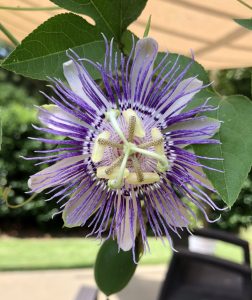 Mother Nature gives us everything we need. I have heard that statement more than once, especially as a naturopath. We just need to pay attention. When I needed a little calm in my life decades ago, I remember taking walks near my house and seeing passion flowers growing in the shrubs reaching for the light. Last summer, there they were again when I was experiencing a great deal of stress. Sometimes the Universe gives you exactly what you need at exactly the right moment. I believe that!
Mother Nature gives us everything we need. I have heard that statement more than once, especially as a naturopath. We just need to pay attention. When I needed a little calm in my life decades ago, I remember taking walks near my house and seeing passion flowers growing in the shrubs reaching for the light. Last summer, there they were again when I was experiencing a great deal of stress. Sometimes the Universe gives you exactly what you need at exactly the right moment. I believe that!
You may ask what is a passion flower (Passiflora). They are these magnificent, tropical-looking flowers that braid their viny tendrils up any neighboring object and the bees love them. In fact, the bees get a bit serene as they feed on the nectar. Passion flowers are known for assisting with sleep, inducing calm and you can find them in many “calming” tea blends.
Let’s look at other plants that can assist our health and well-being. I’ll even include the ingredients and recipes to make your own healing remedies.
Plantain Poultice
Plantain (the herb) is one of many plants that is an invaluable first aid for scrapes, cuts, insect stings, and burns. It is called natures Band-Aid and grows almost everywhere. Plantains (Plantago major) are considered a weed by many, but it looks like a cross between spinach and small Hosta plants. It is well known for its ability to draw out splinters, glass, and other objects that get embedded in the skin. Just make sure you gather it in a clean area.
What’s a poultice?
It’s an application of plant materials or clay that is used on the skin. It can be made fresh or with dried herbs. They are used to soothe, heal, regenerate tissue, improve circulation, relax muscles or even remove foreign particles as mentioned above.
Recipe
Grab a handful of leaves, wash off, and mash up in a bowl. Apply to skin and wrap gauze over to hold in place. After a couple of hours, your plantain will dry up and may need to be replaced. Repeat until the object is removed.
Comfrey Poultice
Comfrey (Symphytum officinale) is one of the most important plants to grow indoors as a first aid source. There are many stories regarding this plant. The principal ingredient is allantoin which is a cell proliferative. It is most useful as an external poultice to heal burns, stings, wounds, and muscle sprains. Comfrey has traditionally been used to heal bone fractures. Do not use internally unless you’re under the guidance of an herbalist or holistic practitioner.
Recipe
Pick the Comfrey leaves, rinse, and shake them dry. Mix with enough distilled water to create a thick mash.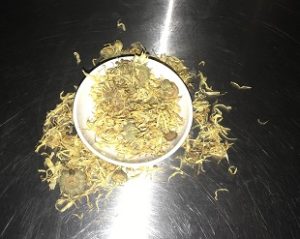 Place in between gauze (like you're making a sandwich). Using the sandwich method ensures the Comfrey isn’t touching skin. Apply to the treatment area, wrapping it with gauze to hold it in place. Occasionally you will see skin rash developing due to small hairs that are found on the leaves. This is why it’s important that the comfrey isn't applied directly to the skin. The gauze sandwich should prevent this; however, if an irritation persists discontinue use.
Place in between gauze (like you're making a sandwich). Using the sandwich method ensures the Comfrey isn’t touching skin. Apply to the treatment area, wrapping it with gauze to hold it in place. Occasionally you will see skin rash developing due to small hairs that are found on the leaves. This is why it’s important that the comfrey isn't applied directly to the skin. The gauze sandwich should prevent this; however, if an irritation persists discontinue use.
Clay Poultice
Clay has been used for centuries to draw out toxins and foreign substances, heal burns and repair damaged tissue.
Ingredients
- 16 ounces of pure green clay
- Distilled water (enough to make a paste)
- Ceramic or glass bowl
- Gauze sandwich or handkerchief
- Cotton gauze
Recipe
Mix the clay with enough water to make a thick paste and spread with a spoon onto the center of a thin gauze diaper or handkerchief in an area approximately 6 to 8 inches and one inch thick. Apply the clay directly to the part of the body to be treated, pressing it into the flesh so that it adheres. Cover with gauze and leave it on until the clay pulls away on its own, indicating that the therapy is completed.
Onion Poultice
This poultice is used in case of lung congestion and bronchial inflammation. It brings penetrating relief to the lungs when it hurts too much to cough. It is also used over the ears and lymph glands to treat ear infections. My grandmother gave me this recipe in my teens and I've used it since then. It works!
Ingredients
- 3 large fresh onions (organic)
- Distilled water
- Skillet
- 2 small towels
- 2 large towels
- Rubber gloves (optional)
- Wooden spoon
Recipe
Slice onions thinly and sauté them. Add a small amount of distilled water until transparent. Fold half of the onions into a gauze diaper so the finished pack is approximately 8 by 8 inches. Apply to the chest as hot as you can stand it, comfortably. Immediately cover it with a towel to retain the heat. Begin preparing the next poultice. When the first one is cool, immediately replace it with the second one. After the therapy, gently dry the chest and rest. Use the same procedure for the ear except make a poultice smaller.
Aloe Vera
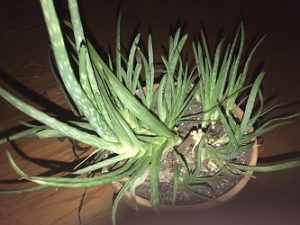 This plant is one of the most useful first aid plant to grow indoors. Simply peel the outer structure of the leaf away to expose the inner gel and wipe it on minor burns sunburns cuts scrapes and more.
This plant is one of the most useful first aid plant to grow indoors. Simply peel the outer structure of the leaf away to expose the inner gel and wipe it on minor burns sunburns cuts scrapes and more.
Wheat Germ, Comfrey and Honey Burn Ointment
This formula has healed thousands of burns and is unique in that it is not removed from the site of injury but is left on until the skin is completely healed. The Wheat Germ oil, Comfrey root, and Honey literally feed the tissue soothing and promoting cell regeneration. It must be made fresh at the time that it is needed as it does not store well.
Recipe
Stir equal parts of Comfrey root powder, Wheat Germ oil and Honey together and apply liberally to the burn. Wrap gauze to hold it in place and replenish as necessary. Use this therapy until the burn is completely healed and it will prevent scarring. If you get tired of wearing a bandage, you can start putting Wheat Germ oil or vitamin E alone on the burn after most of the healing work has been accomplished by the ointment. This period is identified by the absence of pain and general tissue healing to the point that the skin is reddish pink. Keep applying the oil daily until you cannot identify where the burn was.
Banana Peel Poultice for Warts
This is something I remember my grandmother talking about when I was a kid. Simply find a brown to black banana. Take a section of the peel and place the inside part onto the wart. Bind with rolled gauze and leave on overnight, removing in the morning and replacing each night until the ward is gone.
Peppermint Cooling Compress
Cold Compress – what is this? It is used to prevent swelling and reduce fevers. It stimulates the production of white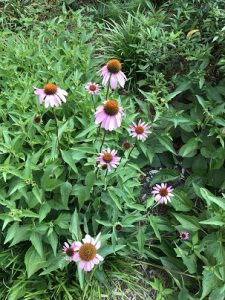 and red blood cells. A decoction or infusion is prepared, allowed to cool, and applied with a cloth.
and red blood cells. A decoction or infusion is prepared, allowed to cool, and applied with a cloth.
Ingredients
- ½ cup Peppermint leaves
- 1 quart distilled water
- Ice cubes
- 1 quart saucepan
- Measuring cup
- Thick cloth
- Towel
Recipe
Pour boiling water over Peppermint (Mentha × piperita) leaves, cover and let steep for 10 minutes. Strain and cool. When it is lukewarm, put in the freezer and add ice cubes to make it really cold. Soak a cloth in the mixture and apply. The cloth should be wrung out so that it does not drip but retains enough liquid to stay cold. If the cloth warms up resoak and reapply. Repeat 3-4 times, adding ice cubes if necessary. Then dry the area thoroughly.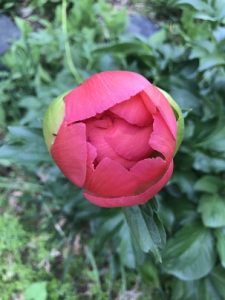
Nature is a healer and when we are aligned with nature through plants, we are in balance. Just remember that not all of nature is without harm and not all herbs are safe. If purchasing, always do so from a source that stocks products from a reputable manufacturer or supplier. These include health food stores or a reputable practitioner. Be aware that some items sold in big online markets may not be what you think. Be wise, be with nature and be well.

